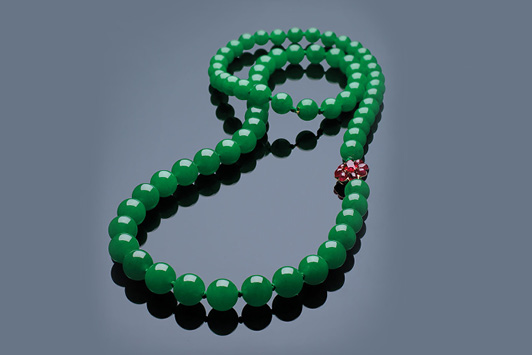
Despite months of unrest disrupting much of the city’s business and daily life, the Christie’s Hong Kong Magnificent Jewels and Jadeite sale on November 26, 2019, posted solid results. The auction of 252 lots achieved approximately $50.9 million, selling 71% by lot and 77% by value. Diamonds — both colored and colorless — made up nine of the top 10 lots. Signed jewels and other vintage pieces performed well, and for the most part, so did colored gems.
J. J. Abram of Hong Kong-based jeweler Ronald Abram Ltd. called the outcome “encouraging.”
“Everything in Hong Kong has been affected by the political situation,” said Abram, whose business specializes in high jewelry and rare gems. “The local market is nowhere near as robust as it has been in the past. To its credit, Christie’s maintained the number of lots for this sale at 252 — similar to 260 in May and 258 last November — while also offering higher-value items. The percentage of lots sold was in line with the previous two sales.”
The political situation did affect in-person attendance, but off-site bidding made up for much of that, stated Vickie Sek, chairman of jewelry at Christie’s
Asia Pacific.
Both she and Abram noted that the higher-end lots did particularly well, an indicator of Asian buyers’ exclusive tastes. “Our Asian collectors are very sophisticated and are willing to collect whatever rare pieces are available in the market,” Sek said. “While our top lots always find the right buyers, we are also trying to source attractive signed pieces
for new collectors to place their first bid
in auction.”
Market uncertainty tends to affect mid-range items, she noted, though “the low-value items did very well, as always.”
Diamonds
Colored diamonds performed as expected, particularly among the top lots, according to Abram.
“The top colored-diamond lots sold at their current market value,” he said. “Consumers in Asia who seek these items are well-versed in the nuances of our trade and are particular in their tastes. Not only are they looking for beautiful, saturated colors, but the certificates need to be problem-free. The auctioneers were appropriately selective in the stones they offered for sale to meet the demands of
the buyers.”
The top lot in this category was a 3.24-carat, fancy-vivid-blue, internally flawless diamond on a ring by Moussaieff that fetched nearly $6.9 million ($2.1 million per carat), within estimates. It was the number-two lot overall.
Colored gems
Among colored gems, Sek noted three important sales: a sapphire, moonstone and diamond set by Bulgari that fetched $971,384 and included a pear-shaped, 55.51-carat Ceylon sapphire cabochon; a ring with a cushion-shaped, 12.59-carat Columbian emerald that went for $755,664; and an oval, 3.12-carat Burmese ruby on a ring that sold for $540,000.
However, two Kashmir sapphires failed to find buyers, added Abram. One of these was a stone of more than 16 carats that Christie’s described as “exceptional”; it was on a Tiffany & Co. ring with an estimate of $1.6 million to $2.3 million. That no one snapped it up was “surprising,” Abram said. “Jewelry buyers in Asia have typically been competitive appreciators of the rarity and provenance of Kashmir sapphires, so this was an unexpected result.”
Signed jewels
Besides the Moussaieff ring, Sek said standout signed items included a Cartier jewelry suite with natural pearls and diamonds that achieved $1.4 million, as well as a Harry Winston necklace with a round brilliant-cut, 18.50-carat diamond that fetched more than $2.5 million.
“Traditional names like Cartier, Bulgari, Harry Winston and Van Cleef & Arpels appear to have performed well, as they tend to do,” observed Abram. “Today’s generation of Asian buyers seems to have overcome the stigma of the previous generation, who generally stayed away from estate pieces, [viewing them] as ‘used.’ Instead, this generation has begun to appreciate the beauty and charm of these pieces.”
Jadeite
Of the 178 lots that sold in the auction, 42 contained jadeite. That included the top lot of the sale: the jadeite and spinel Heavenly Harmony necklace, which fetched more than $9.4 million after attracting bids by four people from four different countries, Sek said.
Jadeite is revered in Asia, but it rarely becomes the top seller in a major international sale. Prices have been flat in recent years except for the rarest pieces, according to collectors. Does this sale signal an increase in demand for jadeite?
Not quite, said Kenneth Chang of K.C.Gems International, a gem dealer based in Seattle, Washington.
“The jadeite market is still soft, with most suppliers still holding on to their finer goods until the right price comes. They are not in a hurry to sell, especially if they know how much the raw material has gone up in Myanmar,” Chang said. “The buyers are always interested in finer-quality large green bead strands, bangles, and nice dome-shaped cabochons, but it’s just a matter of price.”
Sek disputed this assessment, however. “Jadeites are always being sought after, especially by Asian buyers, and often achieve high prices in our auctions,” she asserted. “The reason being, the top quality ones are very, very rare in the market. Our top lot of the sale is the best example to represent its strong demand in the region.”
Image: Sotheby’sArticle from the Rapaport Magazine - January 2020. To subscribe click here.